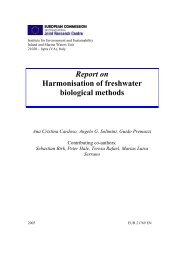Lakes and Watercourses
Lakes and Watercourses
Lakes and Watercourses
Create successful ePaper yourself
Turn your PDF publications into a flip-book with our unique Google optimized e-Paper software.
winter/spring, i.e. ice-covered period, late summer/autumn) over three<br />
years are assessed for all lakes.<br />
Annual minimum values for watercourses are also assessed, although<br />
here assessment should be based on samples taken 12 times a year over<br />
three years. It may be necessary to monitor concentrations more<br />
frequently in small watercourses, particularly during the summer.<br />
TABLE 10.<br />
CURRENT CONDITIONS: oxygen concentration (mg O 2 /l)<br />
Class Description Annual minimum concentration<br />
1 Oxygen-rich ≥ 7<br />
2 Moderately oxygen-rich 5 – 7<br />
3 Moderately oxygen-deficient 3 – 5<br />
4 Oxygen-deficient 1 – 3<br />
5 No or almost no oxygen ≤ 1<br />
Note: The presence of hydrogen sulphide (H 2 S) is indicated by ††<br />
Samples from the deepest point in a stratified lake sometimes give a<br />
misleading picture of oxygen state if only a very small proportion of the<br />
total volume of the lake is deep water. To avoid this, a rule of thumb<br />
should be that readings taken from localities or sampling depths representing<br />
at least 10 per cent of the bottom area of the lake should be used<br />
to reflect the oxygen status of stratified lakes.<br />
TABLE 11.<br />
CURRENT CONDITIONS: organic matter<br />
(oxygen-consuming substances)<br />
Class Description Concentration as TOC or COD Mn (mg/l)<br />
1 Very low concentration ≤ 4<br />
2 Low concentration 4 – 8<br />
3 Moderately high concentration 8 – 12<br />
4 High concentration 12 – 16<br />
5 Very high concentration > 16<br />
30















![Accommodation booking form [PDF]](https://img.yumpu.com/39471785/1/184x260/accommodation-booking-form-pdf.jpg?quality=85)

